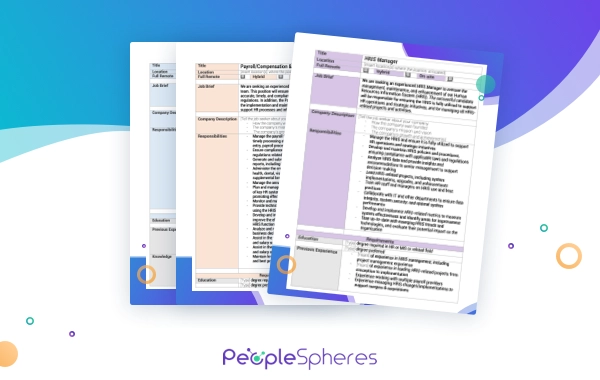-1-640x380.jpg)
Choosing the right Human Resource Information System (HRIS) is a crucial decision that can significantly impact your organization’s efficiency, cost-effectiveness, and overall employee management. This comprehensive HRIS requirements checklist will assist you in streamlining your search by outlining the essential features, capabilities, and integrations your chosen system should possess.
By utilizing this checklist, you can ensure a smooth HRIS selection process, saving you valuable time and resources while ensuring your HRIS meets the unique needs of your organization.
Related articles:
Best-Of-Breed vs All-In-One vs EXP: Which Solution for Your HRIS ?
What is an HRIS? 20 Key Features to Complete your HRIS Experience
HRIS Requirements Checklist
Requirements
When evaluating a new HRIS solution, it’s critical to clearly define your requirements. This includes determining which features are must-haves and which ones are nice-to-haves.
Consider aspects related to compliance, data security, user experience, and scalability. Additionally, assess the level of customization you need in the platform. Make sure to document all these requirements, as they’ll serve as your guide during the selection process.
Core HR Functionality
- Employee data management
- Payroll processing
- Time and attendance tracking
- Leave and absence management
- Compliance with labor laws
- Org chart
- Payroll reporting
- Tax authority integration
- Payslips
Recruitment and Onboarding
- Job posting and applicant tracking
- Candidate scoring
- Automated emails and templates
- Email validation to ensure accurate applicant contact details
- In-app video interviews
- Interview scheduling
- Onboarding workflows
- Calendar integration
- Integration with job boards and social media
Talent Management
- Goal setting and tracking
- Performance appraisals
- Feedback and 360-degree reviews
- Training and development plans
- Compensation management
- Career planning and succession management tools
- Skills and competency tracking
- Learning Management System (LMS)
- Workforce planning tools
Employee Self-Service
- Access to personal information
- Leave requests and approvals
- Document submission and retrieval
- Timesheet submissions
Analytics and Reporting
- Customizable reports and dashboards
- Data visualization tools
- Compliance reporting
- HR analytics for decision-making
- Unified database
Integration and Data Security
- Integration with other software (e.g., ERP, accounting)
- Data encryption and security measures
- Backup and disaster recovery
- Role-based security
- API security testing
Mobile Accessibility
- Mobile app or responsive web design
- Access to HRIS features on smartphones and tablets
User Training and Support
- Employee and administrator training
- Helpdesk and support services
- Knowledge base or FAQs
Customization and Scalability
- Tailoring to specific HR processes
- Ability to scale with business growth
- User role customization
Prioritization
Once you’ve outlined your requirements, it’s time to prioritize them. Not all features carry the same weight; some are more critical to your operations than others. Prioritize the requirements based on their impact on your HR functions. This might involve considering the frequency of use, the number of users, and the overall impact on your organization. Prioritizing requirements can help you make a more informed decision and ensure that key functionalities are not overlooked during the selection process.
Critical Compliance Needs
- Prioritize requirements that ensure legal and regulatory compliance.
Immediate Pain Points
- Address existing HR challenges or bottlenecks.
Cost and Resource Constraints
- Consider the available budget and resources for implementation.
Employee and Manager Feedback
- Gather input from end-users to identify their most pressing needs.
Strategic Business Goals
- Align your HRIS requirements checklist with broader company objectives.
Technology Compatibility
- Assess how HRIS integrates with existing systems and future tech plans.
Align with Growth Plans
Lastly, ensure that your chosen HRIS aligns with your company’s growth plans. As your organization expands, your HR needs will evolve. Your HRIS solution should be scalable and flexible enough to accommodate this growth. Ascertain that the software can handle an increased number of users and that it can support new functionalities as your HR processes become more complex. Remember, a strategic investment in a robust and scalable HRIS solution today can save significant time and resources in the future.
Scalability
- Ensure that the HRIS can accommodate the organization’s growth without major overhauls.
Global Capabilities
- If expansion into new regions is part of the growth plan, verify the HRIS can handle international requirements.
Mobility and Remote Work Support
- Align with the trend of remote work and provide HRIS accessibility from anywhere.
Data Analytics for Decision-Making
- Utilize HRIS data to inform strategic HR decisions and adapt to changing business needs.
Flexible Reporting for Forecasting
- Enable data-driven insights and forecasting to support growth planning.
Training and Onboarding for New Hiress
- Streamline the onboarding process to efficiently integrate new talent into the growing organization.
How to Speed Up Your HRIS Search
Navigating the HR SaaS Market
The HR Software as a Service (SaaS) market can seem like a labyrinth. To effectively navigate it, leveraging the expertise of those who are familiar with the terrain is paramount. This can involve seeking advice from industry experts, seasoned HR professionals, or even from organizations who have recently gone through a similar process.
Furthermore, HRIS solutions that have proven integration abilities should be given priority. Consider HR systems that can easily integrate with your existing software stack to ensure seamless data transfer and to avoid potential compatibility issues.
Involving the Right Stakeholders
Having the right stakeholders involved from the outset can greatly streamline your HRIS search. The process should include those who have the authority to approve the budget, as well as individuals who understand the specific requirements of your industry. Compliance considerations are key — especially in highly regulated industries. The right stakeholders will be able to provide valuable input on necessary features, and help ensure the chosen solution meets all industry-specific regulations.
Expediting Implementation
The implementation phase is often seen as a hurdle, but it can be expedited with the right approach and the right tools. Look for HRIS solutions that offer pre-built smart integrations with applications your team already uses.
This will not only speed up the implementation process but also reduce the learning curve for your staff. Ultimately, the aim should be to minimize disruption for your workforce while transitioning to the new system. A successful implementation is one that allows your teams to swiftly reap the benefits of the new HRIS solution.
Setting Clear Objectives
A streamlined HRIS search begins by establishing unambiguous objectives. To begin, align your HRIS requirements with your organization’s strategic goals, ensuring that the chosen solution supports critical HR management imperatives. Identify and prioritize the specific pain points your HR department and organization are facing, such as manual processes, data inaccuracies, or compliance issues. By understanding these challenges, you can pinpoint the essential features your HRIS should address.
Also it’s important to establish measurable success metrics to gauge the impact of the new system, including reduced administrative workload, improved retention rates, payroll accuracy, and enhanced reporting capabilities.
These objectives provide a solid foundation for your HRIS search, guiding your choice towards a strategic tool that addresses critical issues and contributes to your organization’s overall success. They also help in evaluating and comparing HRIS solutions in the market, facilitating informed decision-making.
Defining Your HRIS Needs
The foundational step in expediting your HRIS search is defining your HRIS requirements checklist within your company. This process begins by identifying your core requirements, ensuring they align with your HR management objectives.
By closely examining the functionality you need, you can address specific human resources (HR) challenges. This includes essential HR tasks, such as talent management, employee performance appraisal, and time-off management.





